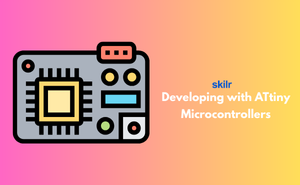👇 CELEBRATE CLOUD SECURITY DAY 👇
00
HOURS
00
MINUTES
00
SECONDS

Working with ATtiny Microcontrollers means creating smart and efficient electronic solutions using very small yet powerful chips. These microcontrollers are affordable, energy-efficient, and versatile, making them perfect for compact devices and projects. They can be programmed to handle a wide range of tasks like reading sensor data, managing inputs and outputs, and running automation tasks.
Put simply, this certification is about turning simple ideas into working electronic systems using ATtiny. Whether it’s a hobby project, a prototype for a product, or learning embedded systems basics, learners will gain the hands-on ability to control hardware through coding and electronics design.
This exam is ideal for:
Industry-endorsed certificates to strengthen your career profile.
Start learning immediately with digital materials, no delays.
Practice until you’re fully confident, at no additional charge.
Study anytime, anywhere, on laptop, tablet, or smartphone.
Courses and practice exams developed by qualified professionals.
Support available round the clock whenever you need help.
Easy-to-follow content with practice exams and assessments.
Join a global community of professionals advancing their skills.
Yes, as long as you have basic knowledge of electronics and coding enthusiasm.
IoT, wearables, robotics, consumer electronics, and prototyping.
Yes, many small electronic devices use ATtiny chips in production.
Examples include smart lights, mini sensors, automated toys, and portable gadgets.
Yes, the certification covers coding as well as circuit design.
No, ATtiny boards and programmers are affordable and widely available.
Mostly C or Arduino-style coding, which is beginner-friendly.
It’s for anyone interested in electronics, embedded systems, or creating DIY projects with microcontrollers.
ATtiny is compact, low-cost, and ideal for small projects where space and simplicity matter.
Basic programming knowledge is helpful, but beginners can learn step by step.